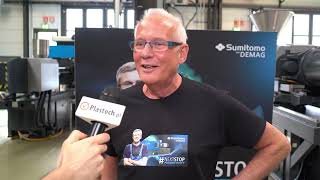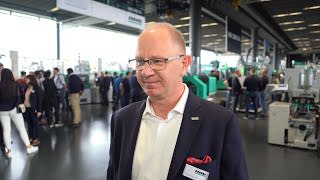
At Fakuma 2021, Sumitomo (SHI) Demag Plastics Machinery GmbH, Schwaig, Germany, will demonstrate the production of backlit IMD badges for use in autonomous driving systems. Comprising an all-electric injection moulding IntElect 220/660-1100 machine, specially equipped with a plasticising unit to process crystal-clear polycarbonate (PC), the pioneering production cell introduces the company’s first SAM-C linear robot developed in-house.
Designed to measure, detect and locate obstacles and enhance autonomous driver safety by interacting with the environment, the moulding specialist will showcase the fully automated production of automotive sensors designed for exterior vehicle applications. To achieve optimal resolution, the seamless IMD process involves back-injecting the radar sensors’ second surface using single-image decors before cleaning the emblem using contactless technology.
Henrik Langwald, Director of Automotive & Electronics Business Development, describes the process: “After the part has been sprayed, the robot enters the mould extracting the finished part using a removal gripper which it places in a receptacle located on the servo motor sliding table. From there it is held in place within the laser station. The sprue is separated, free falling into a box. The cycle then continues towards the CO2 cleaning station, with the robot resuming its standard position. Every cleaned part is removed from the receptacle by the robot using a transfer gripper and placed visible side facing up on the conveyor belt, with the robot continuing the cycle returning to its component extraction position above the mould tool.”

Complex cell batch with IntElect 220t produces autonomous radar-capable vehicle transceivers
Specialists in thin film technology and functional decorative coatings, LEONHARD KURZ Stiftung & Co. KG adapted the innovative IMD process which involves repositioning the IMD films to the movable platen during each cycle using a classic roll-to-roll process with a film feed device. The SAM 10-C linear robot adapted to the fixed clamping plate is used for removal of the component. It then takes over the complete part handling, using suction cups to remove the part from the injection moulding tool, before storing it on the servomotor sliding table and then smoothly transferring the component onto the conveyor belt.
As extremely high-quality and sensitive surfaces, to protect the components from contamination the injection moulding cell is equipped with a movable laminar flow unit. Supplied by airflow experts PETEK Reinraumtechnik, the ISO class 7 cleanroom cell uses the German company’s innovative Flowbox technology to deliver targeted filtered air into the corresponding film feed unit and handle&place automation area, explains Langwald. He adds: “UV curing is not a requirement for this specific application. However, for future flexibility, the exclusion strip can be switched out and the UV module inserted.”
IMD advantages
For high-tech automotive radar surfaces, IMD is an economically viable and more sustainable option, offering the capability, design freedom, repeatability and energy efficient production.
"Indium-based metallisation is radar-compatible," the expert assures. “Using this technique means that the functions of corresponding sensors located around a vehicle are not disturbed. Such systems offer an important design advantage over conventional sensors because they can be concealed using optically non-transparent materials. This is due to the different wavelengths of the radar beams compared to visible light beams.”
Evaluated against lacquer or PVD processes, the IMD manufacturing process is significantly more economical, with the automotive expert reaffirming the benefits of having a continuous, uninterrupted work flow for production and emblem decoration. "Additionally, this will be our first live demonstration of the contactless cleaning technology,” announces Langwald.

The seamless IMD process involves back-injecting the radar sensors’ second surface using single-image decors
Other advantages of the process are design freedom, energy efficiency and sustainability. Through the integration and synergy of the IMD process with the moulding component production, no extra processing is required. This significantly reduces CO2 emissions. "Additionally, during the IMD process decorative layers are transferred as a dry coating system. This eliminates the likelihood of wet coating contamination. Furthermore, no post-drying energy is consumed,” states Langwald.



